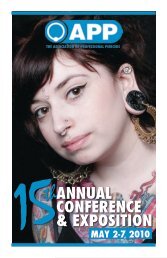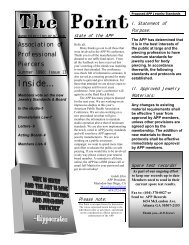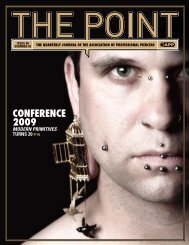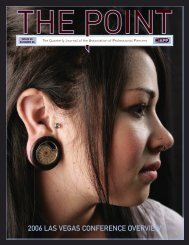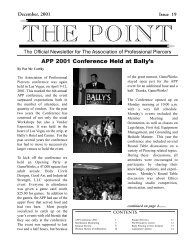Point Journal issue #56 - Association of Professional Piercers
Point Journal issue #56 - Association of Professional Piercers
Point Journal issue #56 - Association of Professional Piercers
Create successful ePaper yourself
Turn your PDF publications into a flip-book with our unique Google optimized e-Paper software.
From Lost to Found Travel:<br />
Body Art and Adornment in India<br />
Kimberly Zapata<br />
Infinite Body Piercing, Inc.<br />
Philadelphia, PA<br />
“The aim <strong>of</strong> art is not to represent the<br />
outward appearance <strong>of</strong> things, but their<br />
inward significance.” —Aristotle<br />
If you were at this year’s APP Conference,<br />
you may have noticed—and even<br />
spoken to—a young woman set up in<br />
the front corner <strong>of</strong> the exposition floor.<br />
Surrounded by images and art, rather than<br />
body jewelry, you may have walked right past<br />
her without realizing it—or you may have<br />
been one <strong>of</strong> many who decided to stop, take a<br />
look, and explore further.<br />
I was first contacted by Allison Rulon-<br />
Miller several weeks prior to Conference<br />
to talk about her tour group, From Lost to<br />
Found Travel. It is a company that specializes<br />
in “special interest tours to the Indian<br />
subcontinent,” including their newest: tours<br />
about body art and adornment in India. My<br />
interest piqued; I responded to Allison’s email<br />
and set up a meeting. Only when I arrived at<br />
her <strong>of</strong>fice—and home—and spoke to her over<br />
a cup <strong>of</strong> freshly ground and brewed Indian<br />
c<strong>of</strong>fee did I realize the story she had to tell.<br />
As we talked, I thought, “How do you<br />
write about a tour you’ve never been on, a<br />
country you’ve never been to?” I cannot tell<br />
a story <strong>of</strong> the tours themselves; I cannot tell<br />
you what I saw, or did, or even what I felt,<br />
since these experiences are not my own. I can<br />
only tell you the story I came to hear: Allison’s<br />
story, a story about the India I have come to<br />
know from halfway around the world, from a<br />
conversation over a cup <strong>of</strong> c<strong>of</strong>fee.<br />
As Allison explained, body art in India<br />
consists <strong>of</strong> both permanent modifications and<br />
temporary, decorative, ritualistic adornment<br />
(think henna, certain types <strong>of</strong> saris, large<br />
beaded necklaces, and bangles and bracelets <strong>of</strong><br />
silver and brass.) “I look at this tour concept<br />
more as body adornment rather than body<br />
modification, the latter being viewed by me<br />
as anything permanent—ritualistic or not.<br />
Body adornment, as I use it as a tour theme,<br />
includes not only tattooing and piercingrelated<br />
jewelry—earrings/nose rings—but<br />
armlets/anklets/talismans/astrological rings,<br />
clothing—traditional and tribal versus highfashion—headwear,<br />
cosmetics/sindur, hair<br />
styles, body painting, and mehndi, among<br />
many other aspects <strong>of</strong> personal appearance,”<br />
she said. “The art <strong>of</strong> getting dressed [there] is<br />
highly ritualistic and deliberate.”<br />
Allison has traveled to India many times<br />
over the last twenty years, and as a woman she<br />
has found herself in a strange yet fortunate<br />
position: In India, it is a cultural taboo for<br />
men to speak directly to women; the same<br />
is true for taking photographs. They must<br />
obtain the permission <strong>of</strong> the husband, father,<br />
or brother <strong>of</strong> the woman, and even with this<br />
permission, the men <strong>of</strong>ten expect something<br />
in exchange. But Allison is granted a certain<br />
amount <strong>of</strong> leeway, allowing her to ask the<br />
questions no one does—and get the incredible<br />
amount <strong>of</strong> photos she does. She says no<br />
one there questions body adornment: their<br />
reasons, rituals, and meanings. To those living<br />
in India, body art and adornment is simply<br />
a part <strong>of</strong> who they are. It is a cultural norm.<br />
Allison, like most Westerners, wanted to know<br />
more. While it was easier for her to ask the<br />
questions few are allowed to ask, it did not<br />
help her receive truer answers.<br />
She observed body art and adornment to<br />
be more prevalent with Indian women than<br />
men. This is not to say that men do not have<br />
ISSUE 56 THE POINT 25








